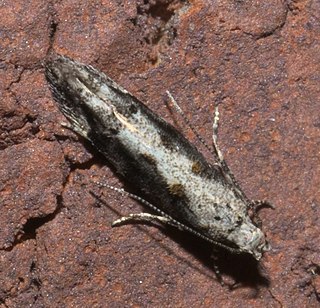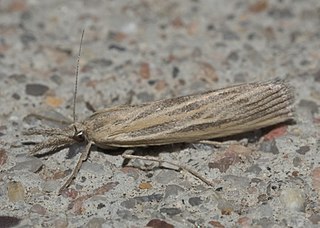
Coleotechnites is a genus of moths in the family Gelechiidae described by Vactor Tousey Chambers in 1880. One of the best known species is the lodgepole needle miner, a serious pest of forest trees in North America.
Mesolia is a genus of moths of the family Crambidae described by Émile Louis Ragonot in 1889.

Prionapteryx is a genus of moths of the family Crambidae.

Thaumatopsis is a genus of moths of the family Crambidae.

Epinotia is a very large genus of tortrix moths. It belongs to the tribe Eucosmini of subfamily Olethreutinae.
Cauchas dietziella is a moth of the family Adelidae or fairy longhorn moths. It was described by William D. Kearfott in 1908. It is found in North America, including Alabama and Massachusetts.
Crambus youngellus, or Young's grass-veneer, is a moth in the family Crambidae. It was described by William D. Kearfott in 1908. It is found in North America, where it has been recorded from north-eastern United States and southern Ontario.
Fissicrambus intermedius is a moth in the family Crambidae. It was described by William D. Kearfott in 1908. It has been recorded from the US states of Arizona, California and Texas.
Microcrambus polingi is a moth in the family Crambidae. It was described by William D. Kearfott in 1908. It is found in the US state of Arizona.

Pediasia dorsipunctella is a moth in the family Crambidae. It was described by William D. Kearfott in 1908. It is found in North America, where it has been recorded from Alberta, Arizona, California, Manitoba, Montana, Nevada, North Dakota and Ontario. The habitat consists of grasslands.
Thaumatopsis atomosella is a moth in the family Crambidae. It was described by William D. Kearfott in 1908. It is found in the US states of Arizona and California.
Thaumatopsis crenulatella is a moth in the family Crambidae. It was described by William D. Kearfott in 1908. It is found in the US states of Arizona, California, Colorado and Nevada.
Eoreuma multipunctellus is a moth in the family Crambidae. It was described by William D. Kearfott in 1908. It has been recorded from the US state of Arizona.
Xubida puritellus is a moth in the family Crambidae. It was described by William D. Kearfott in 1908. It is found in the US state of Arizona.
Hemiplatytes parallela is a moth in the family Crambidae. It was described by William D. Kearfott in 1908. It is found in the US states of Arizona and New Mexico.
Mesolia baboquivariella is a moth in the family Crambidae. It was described by William D. Kearfott in 1907. It is found in the US state of Arizona.
Mesolia huachucaella is a moth in the family Crambidae. It was described by William D. Kearfott in 1908. It is found in the US state of Arizona.
Prionapteryx indentella, the buffalograss webworm, is a moth in the family Crambidae. It was described by William D. Kearfott in 1908. It is found in the US states of Kansas and Texas.
Prolita invariabilis is a moth of the family Gelechiidae. It was described by William D. Kearfott in 1908. It is found in the US states of Utah, Wyoming, Arizona, California, Colorado, Oregon and New Mexico.
Chrysoesthia versicolorella is a moth of the family Gelechiidae. It was described by William D. Kearfott in 1908. It is found in North America, where it has been recorded from California.



